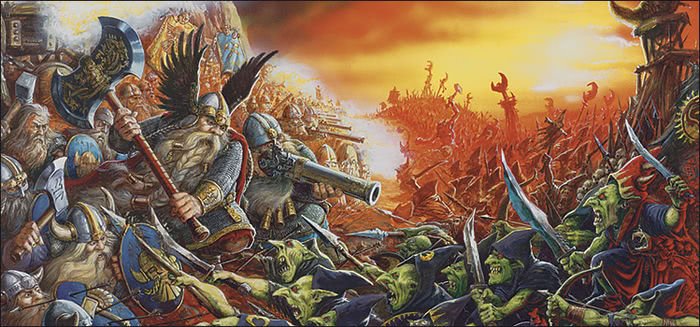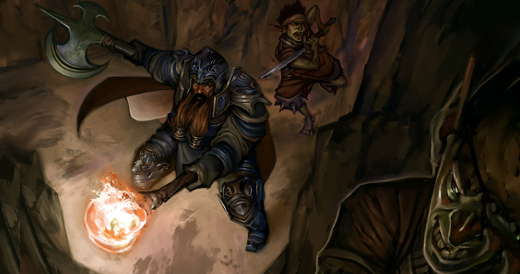An idea I’ve never been able to shake is the D&D racial animus between dwarves and orcs-and-goblins 3.5 D&D presented. This is an idea that stems basically from your Tolkein source material, but it has a weird side effect when you interrogate it, because of time.
Dwarves are so good and so used to fighting orcs and goblins that they have all got an advantage at it. Like, this is stuff baked into their culture so deep their pastry cooks and their ponces all know how to lay into an orc a bit.
Look at this chart (obtained from d20srd.org):
| Race | Middle Age1 | Old2 | Venerable3 | Maximum Age |
|---|---|---|---|---|
| Human | 35 years | 53 years | 70 years | +2d20 years |
| Dwarf | 125 years | 188 years | 250 years | +2d% years |
| Elf | 175 years | 263 years | 350 years | +4d% years |
| Gnome | 100 years | 150 years | 200 years | +3d% years |
| Half-elf | 62 years | 93 years | 125 years | +3d20 years |
| Half-orc | 30 years | 45 years | 60 years | +2d10 years |
| Halfling | 50 years | 75 years | 100 years | +5d20 years |
Ignore the halflings and elves and all that, we’re focusing now on the Half-Orcs and Dwarves. Goblins in the Monster Manuals are said to live a variety of years, depending on which one you read, but they tend to hover around 30 to 40. Orcs and Hobgoblins have a similar range, and Races of Destiny presents a Half-Orc’s lifespan as capping out at an absolute max of 80. By comparison, a dwarf’s maximum age is 450.
A dwarf, by middle age, has seen the rise of nine orc or goblin generations.
Consider what that means to humans. If I fought the man that killed my grandfather when they were both young, that man would be old, now. In this case, an orc facing the dwarf that killed his grandfather is facing someone who time has not weathered at all.
What’s more, the reasons, the motivations for doing so – they’re not around. When you look at how these books present orcs, goblins and dwarves don’t have cities or civilisations; they have things called warrens and camps. They’re presented as being kind of what we’d normally consider ‘pre-civilisational’ and that means they don’t do things like agriculture or writing books that tend to be how we, as people who do agriculture and writing books consider a hallmark of being ‘real’ cultures. Let’s set aside the obvious bias here, and just look at the effect. It’s going to be very hard for these Orc and Goblin cultures to have clear records of what happens when they have wars with the Dwarves.

They don’t have maps or border or maybe even the concept of a country. They’re typically represented as illiterate and use a script that’s not even their own native tongue to write in when they do. They don’t get to know why the dwarves rolled in, but the dwarves do. It’s one of the most obvious things about the dwarf culture as it’s represented: They are old, and they are stubborn, and they remember old grudges.
From the perspective of the orc, the dwarf is an implacable unstoppable juggernaut that emerges from the mountains to kill a generation for reasons that are never truly scrutable. Their armour and weapons are older than your civilisation. They are like cataclysmic storms.
And the dwarves have been doing this for so long that everyone knows how to fight an orc.
Everyone.
And the orcs and goblins and hobgoblins don’t get a bonus against the dwarves.
Consider who’s telling us these stories; the people with their forts and their steel and their axes and their maps and their records who teach their members to murder goblins and orcs and hobgoblins that they never have met and never have any reason to meet. A clockmaker isn’t going out of their way out of the fortress to go forage around in dangerous hobgoblin areas for gear parts. But he knows how to stove an orc’s head in.
Here’s your lesson, game-design wise. These decisions were all made to reinforce flavour from a fiction: In Tolkein’s books, dwarves and orcs were at war, and dwarves were player characters and orcs weren’t, so dwarves got a bonus to help players who play dwarves be excited to fight orcs. The ages follow through from Tolkein too – created monsters like the orcs don’t need a culture, they’re just there to be fought, so it doesn’t matter if they’re short-lived. They’re a byproduct of someone else’s war machine. Dwarves are meant to have long kingdoms and take a long view, so they have to last longer than humans. It all makes sense.
But the mechanical choices made here to represent this flavour create an eerie kind of genocide-capable culture that seems to exist to punish a nearby stone age culture for crimes that culture may not even understand as crimes.
These dwarves seem like they’re really bad, to me.
The dwarf-goblin header art is from Jeffry Lai on deviantart
The bumper image is the cover art for Battle of Skull Pass, which best as I could find was by John Blanche
